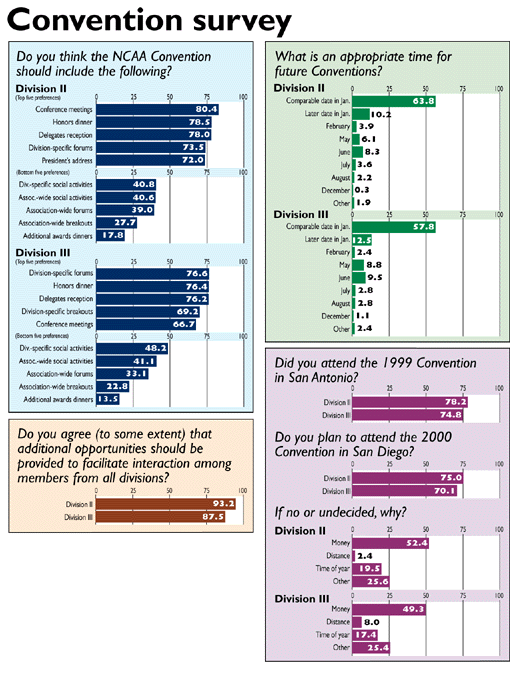
National Collegiate Athletic Association |
The NCAA News DigestJune 21, 1999
Convention surveyRepresentatives from Divisions II and III institutions were surveyed earlier this year about their attitudes toward the annual NCAA Convention. In general, those responding valued the Convention for the opportunity to conduct conference meetings and to discuss division-specific items of interest.
Respondents indicated little desire to change the timing of the Convention. The current time slot in the first half of January was the overwhelming choice in both divisions, with the second choice in both cases being an alternate time in January.
NATIONAL OFFICEMove will affect e-mail and NCAA Online service The relocation of the NCAA staff to Indiana-polis will result in a temporary disruption of electronic-mail and NCAA Online service. NCAA e-mail service will be suspended at the close of the business day Wednesday, July 21. E-mail service is expected to be functional again by the start of business Tuesday, July 27. E-mails sent during the transition period will be returned to the sender. NCAA Online, the Association's site on the World Wide Web, also will be affected temporarily by the move. All NCAA Online services will be down at the close of business July 22. The staff anticipates that NCAA Online will be operational again early in the week of July 26. The staff will move in two "waves." Half the staff will be relocated July 23-26, with the remainder moving July 30-August 2. Staff contact: Sherry Neeb (e-mail) and Jim Jackson (NCAA Online).
GOVERNANCEMailing process underway for 1999-00 Manuals NCAA Divisions II and III Manuals have been mailed to the membership. Mailing for those publications began June 18. The Division I Manual is scheduled to be mailed July 2. Staff contact: Mike Earle.
PLAYING RULESPanel recommends that bats perform to wood standards A panel has announced recommendations that would make wood bats the standard by which nonwood baseball bat performance would be measured, effective January 1, 2000. Among other recommendations, the panel concluded that a batted-ball exit speed should be adjusted for nonwood bats to one that equates to the highest average exit speed using Major League Baseball quality, 34-inch, solid wood bats. The exit-speed standard would be attained via testing using input speeds for both the baseball and bat swing of 80 miles per hour. Staff contact: Stephen A. Hagwell.
|
